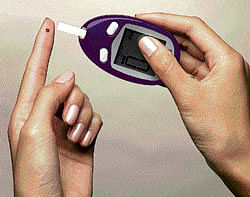Manage diabetes the GI way!

It is a scientifically proven way to measure the effect of carbohydrates on blood sugar levels. Once the food goes into the digestive system, carbohydrates are broken down into sugar and this increases the blood sugar level in the body. GI (Glycemic Index) measures the speed at which the nutrient is broken down and absorbed.
Foods containing carbohydrates that break down rapidly have a high GI (i.e. food rich in simple carbohydrates) and can cause a rapid rise in blood sugar while foods containing carbohydrates that break down slowly have a low GI (i.e. food rich in complex carbohydrates) and bring about a much slower rise in the blood sugar levels.
Knowing the GI value of what you’re consuming works well for diabetics as this helps plan a diet that prevents their blood glucose levels from peaking without warning.
Note: Diabetics who ignore the GI value of their diet are at the risk of various health-related complications such as obesity and cardio-vascular diseases.
Low GI foods, on the other hand, are good for those with diabetes. They bring about a much slower rise in blood sugar levels and should therefore play a very important role in their diet. “Consuming low GI food helps fill up the stomach faster. It stays with you longer and helps avoid overeating. Low GI foods help prevent and manage obesity, which is the major cause of diabetes and heart disease”, says Dr Jyoti Prasad.
Maintaining a healthy lifestyle and a balanced dietary regime is the mantra to managing blood sugar levels. People with diabetes should consume small meals and snack regularly with foods that have low GI value — rich in complex carbohydrates, protein and with extra dietary fibre in between instead of opting for three large meals a day.
Consuming three meals a day may lead to extreme fluctuations in blood sugar levels. This not only poses a greater immediate danger, but also leads to added complications such as cardiovascular diseases, renal disorders, diabetes foot etc.
Do not ignore GI
Low GI foods, as they are digested slowly, provide a steady source of energy over a longer period of time and help you feel full all day long. Therefore, regular snacking with low GI foods (with foods containing high amounts of complex carbohydrates, extra dietary fibre, protein, no trans fat and low cholesterol) in between meals helps diabetic patients stay active by keeping their blood sugar levels under control. Rich sources of complex carbohydrates and extra dietary fibre are available in oats, ragi, legumes, grains, brown rice etc.
It goes almost without saying that one needs to avoid consuming snacks with high cholesterol and high trans fat as this is a known villain. Customised oats and ragi-based snacks made specially for people with diabetes are now available. People with diabetes can pick such ‘Diabetic Friendly Essentials’ as they very well address their nutritional need. Also, one should always check for the GI content of the food products and diabetic-friendly essential products while buying such options (often mentioned on the pack).
The author is the President of the Indian Dietetic Association.
Deccan Herald is on WhatsApp Channels| Join now for Breaking News & Editor's Picks